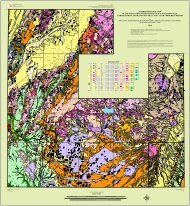Annual review and forecast of Utah coal - Utah Geological Survey ...
Annual review and forecast of Utah coal - Utah Geological Survey ...
Annual review and forecast of Utah coal - Utah Geological Survey ...
Create successful ePaper yourself
Turn your PDF publications into a flip-book with our unique Google optimized e-Paper software.
<strong>Annual</strong> <strong>review</strong> <strong>and</strong> <strong>forecast</strong> <strong>of</strong> <strong>Utah</strong> <strong>coal</strong> production <strong>and</strong> distribution—2009 25<br />
Kolob<br />
5.4%<br />
805 Mst<br />
Emery<br />
5.3%<br />
802 Mst<br />
Book Cliffs<br />
4.5%<br />
677 Mst<br />
Henry Mountains<br />
3.2%<br />
485 Mst<br />
Other<br />
5.5%<br />
825 Mst<br />
Alton<br />
7.0%<br />
1056 Mst<br />
Wasatch Plateau<br />
8.4%<br />
1268 Mst<br />
Kaiparowits<br />
60.6%<br />
9096 Mst<br />
Source: Smith <strong>and</strong> Jahanbani, 1988; Quick <strong>and</strong> others, 2004; Bon <strong>and</strong> others, 2006<br />
Note: Mst – Million short tons, data available in appendix table A4<br />
Figure 7. Remaining estimated recoverable resources in <strong>Utah</strong> by <strong>coal</strong>field, 2009.<br />
40<br />
20<br />
0<br />
Cumulative tonnage leased<br />
minus cumulative production<br />
Reggression line showing<br />
negative trend<br />
Million short tons<br />
-20<br />
-40<br />
-60<br />
-80<br />
-100<br />
1975 1980 1985 1990 1995 2000 2005<br />
Source: BLM, SITLA, UGS<br />
Note: The negative trend indicates <strong>coal</strong> is being produced faster than new tonnage is being leased.<br />
Figure 8. Net increase/loss <strong>of</strong> new <strong>coal</strong> tonnage leased in <strong>Utah</strong> compared to cumulative production,<br />
1975–2009.<br />
southern part <strong>of</strong> the Emery <strong>coal</strong>field is located near unleased<br />
resources that could total more than 100 million<br />
tons, including resources in the Hidden Valley area, but<br />
these resources tend to have higher sulfur contents. Also,<br />
the proposed mine in the Alton <strong>coal</strong>field could produce up<br />
to 2.0 million tons per year <strong>of</strong> subbituminous <strong>coal</strong> from a<br />
projected reserve base <strong>of</strong> 40 to 45 million tons. These resources,<br />
<strong>and</strong> others, may become more attractive if prices<br />
keep rising <strong>and</strong> <strong>coal</strong> washing becomes more economic.

















